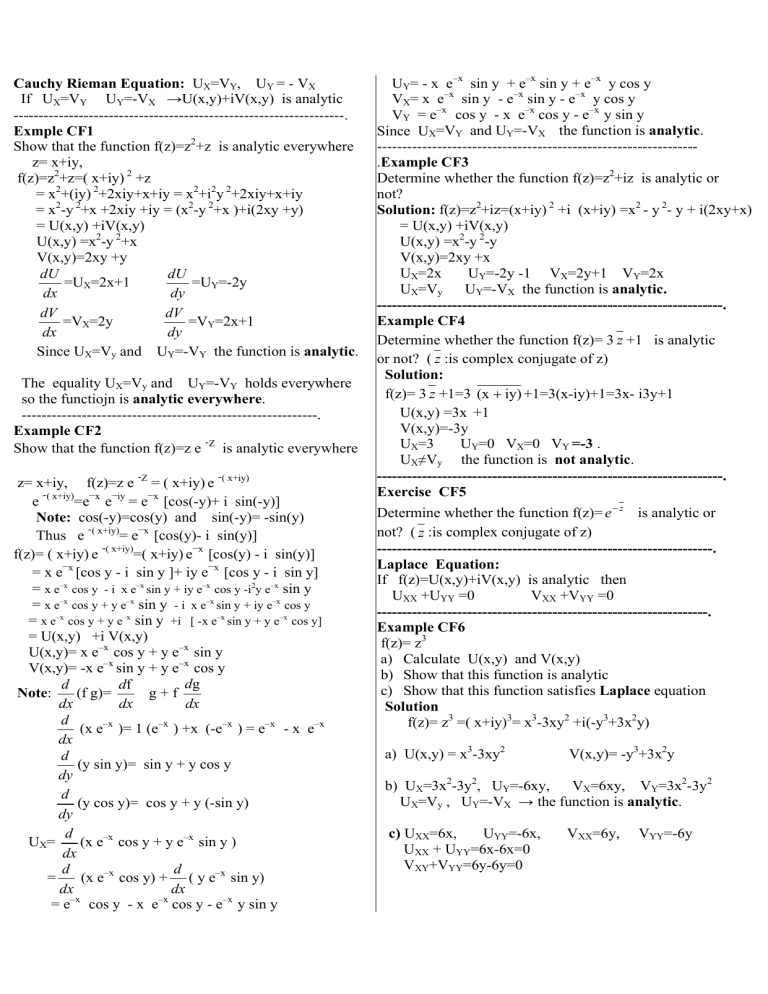
Cauchy Rieman Equation: UX=VY, UY = - VX
If UX=VY UY=-VX →U(x,y)+iV(x,y) is analytic
------------------------------------------------------------------.
Exmple CF1
Show that the function f(z)=z2+z is analytic everywhere
z= x+iy,
f(z)=z2+z=( x+iy) 2 +z
= x2+(iy) 2+2xiy+x+iy = x2+i2y 2+2xiy+x+iy
= x2-y 2+x +2xiy +iy = (x2-y 2+x )+i(2xy +y)
= U(x,y) +iV(x,y)
U(x,y) =x2-y 2+x
V(x,y)=2xy +y
dU
dU
=UX=2x+1
=UY=-2y
dy
dx
dV
dV
=VX=2y
=VY=2x+1
dx
dy
Since UX=Vy and UY=-VY the function is analytic.
The equality UX=Vy and UY=-VY holds everywhere
so the functiojn is analytic everywhere.
-----------------------------------------------------------.
Example CF2
Show that the function f(z)=z e Z is analytic everywhere
-
-
z= x+iy, f(z)=z e Z = ( x+iy) e ( x+iy)
– –
–
e ( x+iy)=e x e iy = e x [cos(-y)+ i sin(-y)]
Note: cos(-y)=cos(y) and sin(-y)= -sin(y)
–
Thus e ( x+iy)= e x [cos(y)- i sin(y)]
–
f(z)= ( x+iy) e ( x+iy)=( x+iy) e x [cos(y) - i sin(y)]
–
–
= x e x [cos y - i sin y ]+ iy e x [cos y - i sin y]
= x e–x cos y - i x e–x sin y + iy e–x cos y -i2y e–x sin y
= x e–x cos y + y e–x sin y - i x e–x sin y + iy e–x cos y
= x e–x cos y + y e–x sin y +i [ -x e–x sin y + y e–x cos y]
= U(x,y) +i V(x,y)
U(x,y)= x e–x cos y + y e–x sin y
V(x,y)= -x e–x sin y + y e–x cos y
dg
d
df
(f g)=
g+f
Note:
dx
dx
dx
d
–x
–x
(x e )= 1 (e ) +x (-e–x ) = e–x - x e–x
dx
d
(y sin y)= sin y + y cos y
dy
d
(y cos y)= cos y + y (-sin y)
dy
d
UX=
(x e–x cos y + y e–x sin y )
dx
d
d
(x e–x cos y) + ( y e–x sin y)
=
dx
dx
= e–x cos y - x e–x cos y - e–x y sin y
UY= - x e–x sin y + e–x sin y + e–x y cos y
VX= x e–x sin y - e–x sin y - e–x y cos y
VY = e–x cos y - x e–x cos y - e–x y sin y
Since UX=VY and UY=-VX the function is analytic.
---------------------------------------------------------------.Example CF3
Determine whether the function f(z)=z2+iz is analytic or
not?
Solution: f(z)=z2+iz=(x+iy) 2 +i (x+iy) =x2 - y 2- y + i(2xy+x)
= U(x,y) +iV(x,y)
U(x,y) =x2-y 2-y
V(x,y)=2xy +x
UX=2x
UY=-2y -1 VX=2y+1 VY=2x
UX=Vy UY=-VX the function is analytic.
---------------------------------------------------------------------.
Example CF4
Determine whether the function f(z)= 3 z +1 is analytic
or not? ( z :is complex conjugate of z)
Solution:
f(z)= 3 z +1=3 (x + iy) +1=3(x-iy)+1=3x- i3y+1
U(x,y) =3x +1
V(x,y)=-3y
UX=3
UY=0 VX=0 VY =-3 .
UX≠Vy the function is not analytic.
---------------------------------------------------------------------.
Exercise CF5
Determine whether the function f(z)= e − z is analytic or
not? ( z :is complex conjugate of z)
-------------------------------------------------------------------.
Laplace Equation:
If f(z)=U(x,y)+iV(x,y) is analytic then
UXX +UYY =0
VXX +VYY =0
------------------------------------------------------------------.
Example CF6
f(z)= z3
a) Calculate U(x,y) and V(x,y)
b) Show that this function is analytic
c) Show that this function satisfies Laplace equation
Solution
f(z)= z3 =( x+iy)3= x3-3xy2 +i(-y3+3x2y)
a) U(x,y) = x3-3xy2
V(x,y)= -y3+3x2y
b) UX=3x2-3y2, UY=-6xy,
VX=6xy, VY=3x2-3y2
UX=Vy , UY=-VX → the function is analytic.
c) UXX=6x,
UYY=-6x,
UXX + UYY=6x-6x=0
VXY+VYY=6y-6y=0
VXX=6y,
VYY=-6y
